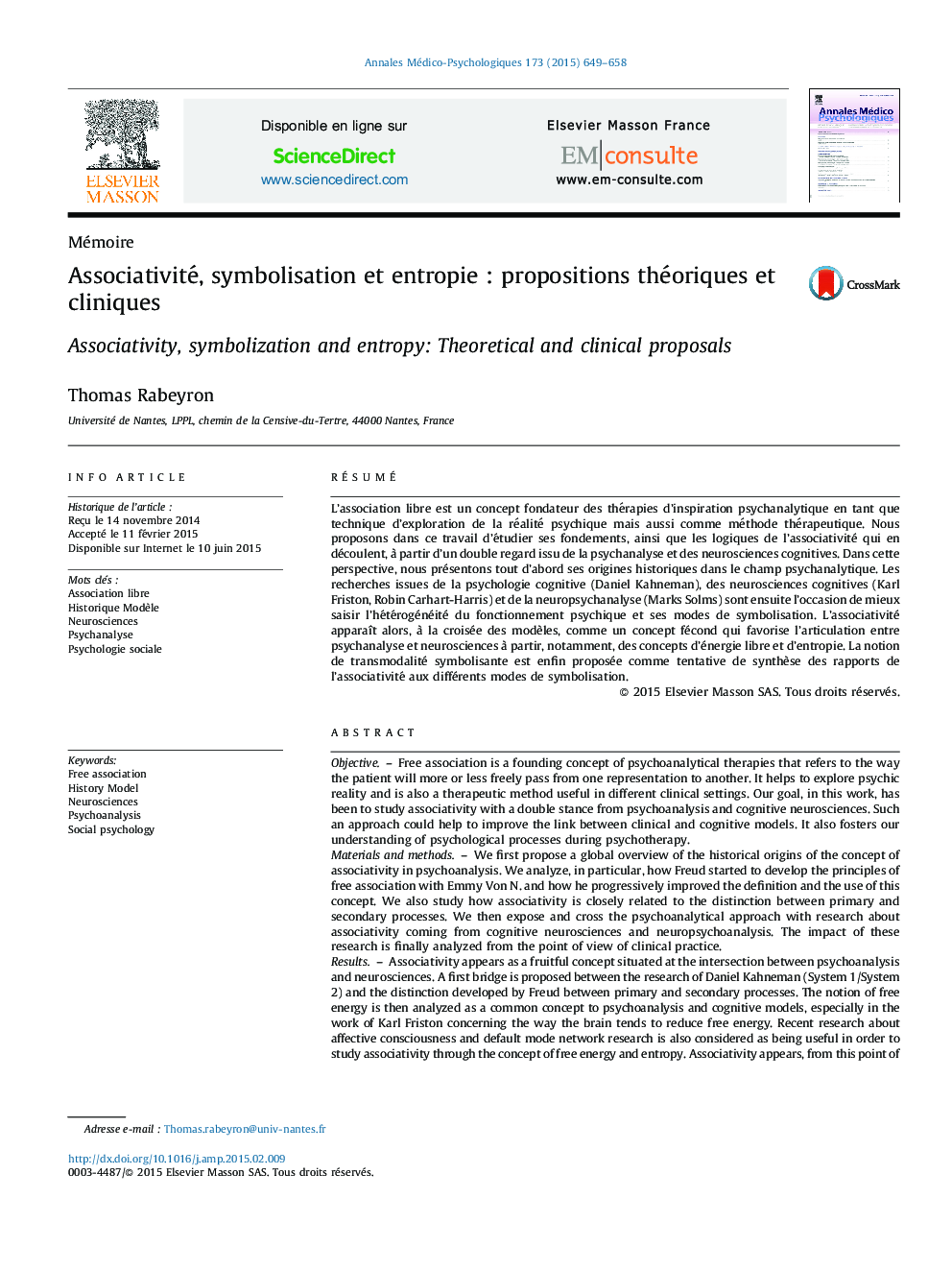| کد مقاله | کد نشریه | سال انتشار | مقاله انگلیسی | نسخه تمام متن |
|---|---|---|---|---|
| 314622 | 534697 | 2015 | 10 صفحه PDF | دانلود رایگان |

RésuméL’association libre est un concept fondateur des thérapies d’inspiration psychanalytique en tant que technique d’exploration de la réalité psychique mais aussi comme méthode thérapeutique. Nous proposons dans ce travail d’étudier ses fondements, ainsi que les logiques de l’associativité qui en découlent, à partir d’un double regard issu de la psychanalyse et des neurosciences cognitives. Dans cette perspective, nous présentons tout d’abord ses origines historiques dans le champ psychanalytique. Les recherches issues de la psychologie cognitive (Daniel Kahneman), des neurosciences cognitives (Karl Friston, Robin Carhart-Harris) et de la neuropsychanalyse (Marks Solms) sont ensuite l’occasion de mieux saisir l’hétérogénéité du fonctionnement psychique et ses modes de symbolisation. L’associativité apparaît alors, à la croisée des modèles, comme un concept fécond qui favorise l’articulation entre psychanalyse et neurosciences à partir, notamment, des concepts d’énergie libre et d’entropie. La notion de transmodalité symbolisante est enfin proposée comme tentative de synthèse des rapports de l’associativité aux différents modes de symbolisation.
ObjectiveFree association is a founding concept of psychoanalytical therapies that refers to the way the patient will more or less freely pass from one representation to another. It helps to explore psychic reality and is also a therapeutic method useful in different clinical settings. Our goal, in this work, has been to study associativity with a double stance from psychoanalysis and cognitive neurosciences. Such an approach could help to improve the link between clinical and cognitive models. It also fosters our understanding of psychological processes during psychotherapy.Materials and methodsWe first propose a global overview of the historical origins of the concept of associativity in psychoanalysis. We analyze, in particular, how Freud started to develop the principles of free association with Emmy Von N. and how he progressively improved the definition and the use of this concept. We also study how associativity is closely related to the distinction between primary and secondary processes. We then expose and cross the psychoanalytical approach with research about associativity coming from cognitive neurosciences and neuropsychoanalysis. The impact of these research is finally analyzed from the point of view of clinical practice.ResultsAssociativity appears as a fruitful concept situated at the intersection between psychoanalysis and neurosciences. A first bridge is proposed between the research of Daniel Kahneman (System 1/System 2) and the distinction developed by Freud between primary and secondary processes. The notion of free energy is then analyzed as a common concept to psychoanalysis and cognitive models, especially in the work of Karl Friston concerning the way the brain tends to reduce free energy. Recent research about affective consciousness and default mode network research is also considered as being useful in order to study associativity through the concept of free energy and entropy. Associativity appears, from this point of view, as a way for the psyche to integrate high and low degree of entropy at different levels of organization of the brain.ConclusionsSymbolization is linked to several and specific forms of associativity processes. We propose to call “primary associativity” a first form of associativity that deals with primary processes. By contrast, secondary associativity rather concerns the impact of these processes at higher level of the psychic apparatus. The transition of one form of associativity to the other has a strong impact on the psychotherapeutic efficacy. We propose more precisely to call this transition process “transmodal symbolization”.
Journal: Annales Médico-psychologiques, revue psychiatrique - Volume 173, Issue 8, October 2015, Pages 649–658